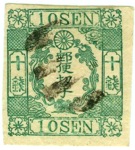
Discussion - Member to Member Sales - Research Center

Discussion - Member to Member Sales - Research Center


Looks to be 1930-40ish, but unable to find, getting old I guess!

Login to Like
this post
Try Greece, 1955 (Antique Arts)

Login to Like
this post
Scott #579, thank you very much, I was missing seeing those at the bottom of the page, no illustrations of course.
When I first looked at the stamp I thought they were dogs chasing a fish, especially with the rippled background. Took me a while to realise it was an hunting scene.
Thanks again.

Login to Like
this post
When I have stamps to list for sale the catalog is not the first place I look to identify a particular stamp. Instead I go to my collection site where most stamps for the world are shown depending on end date of a particular country collection. Stamps can easily be found by estimating the date and looking through the thumbnails of the pages. I found the stamp in question in less than 30 seconds and it did not require dragging out a catalog. A great number of stamps seem to be nearly impossible to find in the catalogs. Many of these are
stamps in sets that are not pictured.
World A-Z index: http://mitch.seymourfamily.com/mward/collection/indexa-z.html


1 Member
likes this post.
Login to Like.
I quite agree Mitch but I was actually going through an envelope of Greek stamps to get them in Scott order ready to make up an approval book, so the catalogue was already open.
Usually what I do when I am unable to find a stamp is to check for date from postmark, year imprinted on stamp, or when all else fails go through looking for stamps of the value concerned. In this case I had missed the entry at the bottom of the page where it was listed.
I actually put the stamps in the catalogue, page by page, prior to putting them in order on sales sheets. This way they are in a reasonable order for sales perusal.
Probably the long way round but it works for me.

Login to Like
this post
Most countries design their sets so there is a "family resemblance" between all the stamps in the set ( the same frame for example.)
Greek stamps of this period are one of the exceptions ( modern ones are easy ) so Mich is right about looking at a "pictorial" website like his.
Sometimes catalogue notes are not helpful, as the title of the stamp design presupposes some knowledge of the subject. For example as an amateur botanist/ keen gardener I can often identify plants by their taxonomic name while other poor mortals have no chance ! Do you know what Atriplex Hortensis looks like ?

Login to Like
this post
Yes and I have eaten it when weeding the garden. Orache. But I cheat because I was, for a while, chargehand gardener in Kensington Gardens and for a few years organised the floral displays and shrub beds.

Login to Like
this post

Help on this one please before I go mad. Have searched through the catalogue but can find nothing even vaguely similar.

Looks to be 1930-40ish, but unable to find, getting old I guess!

Login to Like
this post
06:37:52pm
re: Greek mystery stamp
Try Greece, 1955 (Antique Arts)

Login to Like
this post

re: Greek mystery stamp
Scott #579, thank you very much, I was missing seeing those at the bottom of the page, no illustrations of course.
When I first looked at the stamp I thought they were dogs chasing a fish, especially with the rippled background. Took me a while to realise it was an hunting scene.
Thanks again.

Login to Like
this post

re: Greek mystery stamp
When I have stamps to list for sale the catalog is not the first place I look to identify a particular stamp. Instead I go to my collection site where most stamps for the world are shown depending on end date of a particular country collection. Stamps can easily be found by estimating the date and looking through the thumbnails of the pages. I found the stamp in question in less than 30 seconds and it did not require dragging out a catalog. A great number of stamps seem to be nearly impossible to find in the catalogs. Many of these are
stamps in sets that are not pictured.
World A-Z index: http://mitch.seymourfamily.com/mward/collection/indexa-z.html


1 Member
likes this post.
Login to Like.

re: Greek mystery stamp
I quite agree Mitch but I was actually going through an envelope of Greek stamps to get them in Scott order ready to make up an approval book, so the catalogue was already open.
Usually what I do when I am unable to find a stamp is to check for date from postmark, year imprinted on stamp, or when all else fails go through looking for stamps of the value concerned. In this case I had missed the entry at the bottom of the page where it was listed.
I actually put the stamps in the catalogue, page by page, prior to putting them in order on sales sheets. This way they are in a reasonable order for sales perusal.
Probably the long way round but it works for me.

Login to Like
this post
09:30:13am
re: Greek mystery stamp
Most countries design their sets so there is a "family resemblance" between all the stamps in the set ( the same frame for example.)
Greek stamps of this period are one of the exceptions ( modern ones are easy ) so Mich is right about looking at a "pictorial" website like his.
Sometimes catalogue notes are not helpful, as the title of the stamp design presupposes some knowledge of the subject. For example as an amateur botanist/ keen gardener I can often identify plants by their taxonomic name while other poor mortals have no chance ! Do you know what Atriplex Hortensis looks like ?

Login to Like
this post

re: Greek mystery stamp
Yes and I have eaten it when weeding the garden. Orache. But I cheat because I was, for a while, chargehand gardener in Kensington Gardens and for a few years organised the floral displays and shrub beds.

Login to Like
this post

